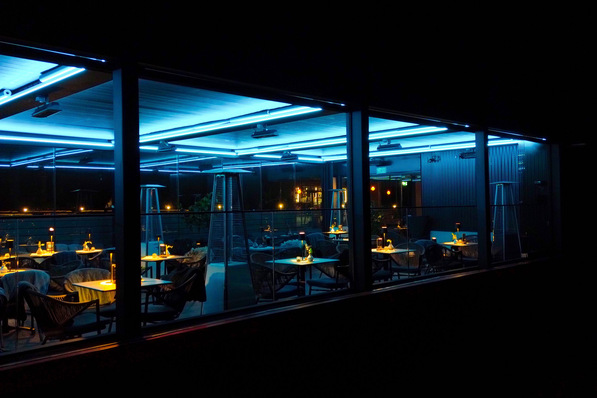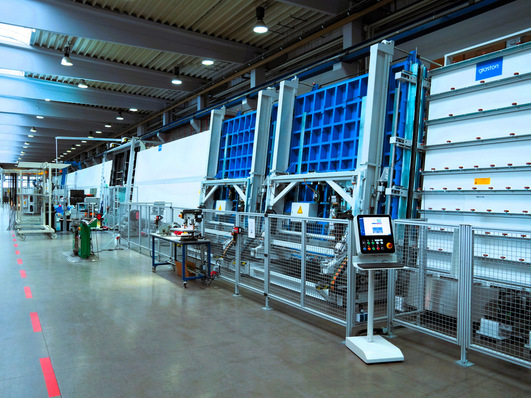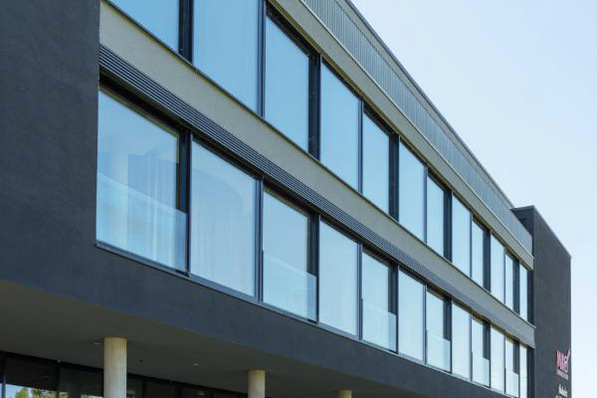A delicate, curved concrete roof and self-learning building technology are the striking features of the HiLo building unit on the roof of the NEST research building at ETH Zurich in Dübendorf (Switzerland). The two-storey building module was planned and built using state-of-the-art design and fabrication methods. Inspired by the structures of historic, self-supporting cathedral ceilings, the ETH researchers created a building in which lightweight construction methods were tested and combined with intelligent and adaptive building systems.
The unit is designed as a two-storey collaborative and flexible workspace with two closed offices and several shared, open office areas. HiLo stands for "High Performance -Low Emissions". The Contraflam 30 Climatop fire-resistant glazing from Vetrotech Saint-Gobain, which was manufactured in various geometries and special shapes to fit the curved facade, provides the necessary fire protection in the lightweight construction. In addition, they also offer safety and climate comfort thanks to the corresponding structure.
How is the use of materials minimised on the building?
The double-curved roof gains its load-bearing capacity from its geometry and its double-skin structure. It consists of a double-curved, two-layer concrete shell based on flexible formwork that was largely built from reusable elements.

Roman Keller
Thanks to the special design of the floor, material only had to be installed where it was structurally required according to the force flow of compression and tension. HiLo's lightweight floor construction thus saves more than 70% of material compared to conventional concrete floors. The intermediate floors also have an embedded heating and cooling network.
Sun shading and safety in an adaptive facade
Essential elements of the construction principle in the HiLo unit are, in addition to material savings, the reduction of emissions and energy demand. This is achieved through a combination of various measures, including the use of innovative building technology components that efficiently regulate the indoor climate.
See also: Fire-resistant glass with the 'wow' factor
These include an adaptive solar facade specially developed for the HiLo unit, made of flexible photovoltaic modules that control the incidence of sunlight into the space to provide passive heating or reduce cooling requirements as needed, and electrochromic glazing from SageGlass that regulates the brightness in the building while also serving as solar and thermal protection.

Roman Keller
The individual glasses were adapted directly to the curved roof shape, for which no mechanical sun shading would have been possible. Where fire protection was required in the facade due to the proximity to other buildings, fire-resistant glazing in the form of triple insulating glass Contraflam 30 Climatop from Vetrotech Saint-Gobain was used. Here, too, special solutions were required to adapt the glass to the facade.
The glass was therefore manufactured as polygons with angled edges in different dimensions. The customised multifunctional glazing, combined with safety, solar and thermal protection properties, thus fulfils all requirements for efficiency as well as aesthetics. In addition, the coating of the glass was matched in colour to the other facade glass, so that the building envelope appears uniform and of high quality.
Self-learning technology for room comfort
All solutions used in the HiLo building are intended to contribute to providing the residents with a high level of comfort with minimal energy consumption. Therefore, a holistic concept was developed so that HiLo functions as an intelligent and learning operation.

Roman Keller
Also interesting: Eastman: 8 metre high bird protection glass involving 'mirrors'
The modern heating, shading and ventilation systems learn from operating data, for example from the temperatures, lighting conditions and air qualities preferred by the occupants. At the same time, they also learn from the building: visualisations show them, for example, how they can reduce energy consumption without having to sacrifice comfort.
The HiLo impressively demonstrates how the integration of novel building systems in lightweight structures enables energy-efficient operation and a high level of comfort for the users.
About the NEST test building
The NEST test building on the campus of the two research institutions Empa and Eawag is a modular research and innovation building. Here, scientists and industrial partners can test and further develop new building and energy technologies in temporary building modules or units and under "real" conditions. As part of the industrial partnership, Vetrotech Saint-Gobain developed the special fire-resistant glass for HiLo.













